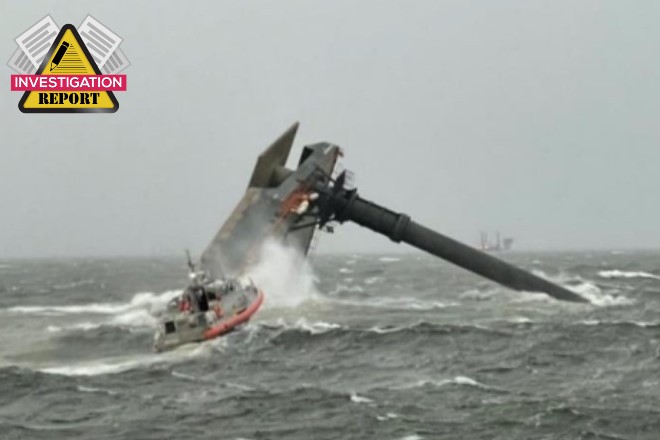NTSB published the executive summary of the report regarding Seacor Power, which capsized off the coast of Port Fourchon, Louisiana. According to the report, severe winds led to the incident.
The incident
On April 13, 2021, about 1537 local time, the US-flagged liftboat SEACOR Power capsized about 7 miles off the coast of Port Fourchon, Louisiana, in a severe thunderstorm. Eleven crew and eight offshore workers were aboard the liftboat.
Vessel operators in the area reported heavy rain, winds exceeding 80 knots, and 2- to 4-foot seas at the time of the capsizing. Search and rescue efforts were hampered by 30- to 40-knot winds and seas that quickly built to 10 to 12 feet and persisted throughout the evening and into the next day.
Six personnel were rescued by the US Coast Guard and Good Samaritan vessels, and the bodies of six fatally injured personnel were recovered. Seven personnel were never found and are presumed dead. The vessel, valued at $25 million, was a total constructive loss.
Analysis
The captain’s decision to get underway on the day of the casualty was reasonable and was not influenced by commercial pressure. However, weather information that SEACOR Marine provided to the SEACOR Power’s crew was insufficient for making weather-related decisions about the liftboat’s operation.
Additionally, due to a Coast Guard broadcasting station outage, the SEACOR Power crew did not receive a National Weather Service Special Marine Warning notifying mariners of a severe thunderstorm that was approaching.
Even if the SEACOR Power crew had received the Special Marine Warning, data gaps, including a lack of low-altitude radar visibility over the Louisiana coastal areas, prevented the National Weather Service office that issued the Special Marine Warning from identifying and forecasting the surface wind magnitudes that impacted the SEACOR Power. Lowering the angle of the lowest radar beam at select coastal weather radar sites would improve low-altitude radar visibility over coastal waters.
The capsizing occurred when the SEACOR Power was struck by severe thunderstorm generated winds that exceeded the vessel’s operational wind speed limits, causing a loss of stability. Other operational factors may have also played a role in the capsizing, including the liftboat’s trim by the stern (the difference between a ship’s forward and aft drafts), its turn to port and speed through the water, a cargo shift, and movement of the vessel’s legs.
Due to the unpredictability of thunderstorm phenomena and the vulnerability of restricted-service liftboats like the SEACOR Power, operating restricted service liftboats like the SEACOR Power in the afloat mode at any time when a Special Marine Warning has been issued for the vessel’s planned route increases their risk of capsizing. Further, increasing minimum stability criteria for liftboats in restricted service would improve vessel survivability in severe thunderstorms.
The speed at which the SEACOR Power capsized and angle at which it came to rest made egress difficult and likely contributed to the fatalities. Following the capsizing, the Coast Guard Response Command Center did not effectively use available information to verify the validity of the location of SEACOR Power’s emergency position indicating radio beacon alerts, which led to a delay in dispatching search and rescue units and notifying Good Samaritan vessels of the emergency.
Additionally, SEACOR Marine did not have adequate procedures nor did it provide its staff with training for responding to the Coast Guard when contacted regarding emergency position indicating radio beacon alerts, and inaccurate information about the SEACOR Power’s location provided to the Coast Guard by a SEACOR Marine employee contributed to the delayed response.
High winds and heavy seas, combined with underwater and overhead obstructions, prevented both surface and air resources from getting close enough to the vessel to rescue personnel directly from the wreck, which contributed to the loss of life. In the future, a detailed procedure in Coast Guard mass rescue operations plans combined with mutual aid agreements between the Coast Guard and air rescue providers would improve and expand search and rescue capabilities.
In previous casualty investigations, we found that mariners have benefited from their vessels or employers providing personal locator beacons; had the crewmembers of the SEACOR Power been required to carry personal locator beacons, their chances of being rescued would have been enhanced. The search and rescue transponder held by the mate after he had been swept into the water from the wreck was not effective in signaling vessels or aircraft.
Probable cause
The probable cause of the capsizing of the liftboat SEACOR Power was a loss of stability that occurred when the vessel was struck by severe thunderstorm winds, which exceeded the vessel’s operational wind speed limits.
Contributing to the loss of life on the vessel were the speed at which the vessel capsized and the angle at which it came to rest, which made egress difficult, and the high winds and seas in the aftermath of the capsizing, which hampered rescue efforts.
Recommendations
Because the localized weather could not be detected by nearby radars due to their elevation angles (antenna angles relative to the horizon), we recommended that that the National Weather Service, Federal Aviation Administration, and Air Force work together to assess coastal weather radar sites to determine if it is safe and appropriate to lower the radar angles, and then lower the angles of the lowest radar beams where appropriate.
NTSB also recommended that the Coast Guard develop procedures to inform mariners in affected areas whenever there is an outage at a navigational telex broadcasting site, modify restricted-service liftboat stability regulations to require greater stability for newly constructed restricted-service liftboats, and develop procedures to integrate commercial, municipal, and non-profit air rescue providers into Sectors’ and Districts’ mass rescue operations plans, when appropriate.
Further, NTSB reiterated a recommendation to the Coast Guard to require that all personnel employed on vessels in coastal, Great Lakes, and ocean service be provided with a personal locator beacon to enhance their chances of survival. Given the benefits of personal locator beacons, we also recommended that the Offshore Marine Service Association notify members of personal locator beacons’ availability and value.
Lastly, NTSB recommended that SEACOR Marine review its fleet to ensure its vessels are being operated strictly within the limits specified in operating manuals, stability documentation, and other required guidance, and revise its liftboat safety management system and operations manuals to include a policy requiring the vessel to remain in port or lower its legs and cease afloat operations when a Special Marine Warning has been issued for the vessel’s planned route.
The report finally recommended that the Offshore Marine Service Association inform their members of the circumstances of this accident and the importance of remaining in port or jacking up when a Special Marine Warning has been issued.




























































